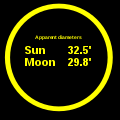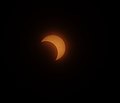| Annular eclipse | |
 Annularity from Palangka Raya, Indonesia | |
| Gamma | −0.282 |
|---|---|
| Magnitude | 0.9282 |
| Maximum eclipse | |
| Duration | 474 s (7 min 54 s) |
| Coordinates | 34°06′S70°12′E / 34.1°S 70.2°E |
| Max. width of band | 280 km (170 mi) |
| Times (UTC) | |
| Greatest eclipse | 7:59:45 |
| References | |
| Saros | 131 (50 of 70) |
| Catalog # (SE5000) | 9527 |
An annular solar eclipse occurred at the Moon's ascending node of orbit on Monday, January 26, 2009, [1] [2] [3] with a magnitude of 0.9282. A solar eclipse occurs when the Moon passes between Earth and the Sun, thereby totally or partly obscuring the image of the Sun for a viewer on Earth. An annular solar eclipse occurs when the Moon's apparent diameter is smaller than the Sun's, blocking most of the Sun's light and causing the Sun to look like an annulus (ring). An annular eclipse appears as a partial eclipse over a region of the Earth thousands of kilometres wide. Occurring about 3.3 days after apogee (on January 23, 2009, at 0:10 UTC), the Moon's apparent diameter was smaller. [4]
Contents
- Images
- Eclipse timing
- Places experiencing annular eclipse
- Places experiencing partial eclipse
- Gallery
- Eclipse details
- Eclipse season
- Related eclipses
- Eclipses in 2009
- Metonic
- Tzolkinex
- Half-Saros
- Tritos
- Solar Saros 131
- Inex
- Triad
- Solar eclipses of 2008–2011
- Saros 131
- Metonic series
- Tritos series
- Inex series
- Notes
- References
The eclipse was visible from a narrow corridor beginning in the south Atlantic Ocean and sweeping eastward 900 km south of Africa, slowly curving northeast through the Indian Ocean. Its first landfall was in the Cocos Islands followed by southern Sumatra and western Java. It continued somewhat more easterly across central Borneo, across the northwestern edge of Celebes, then ending just before Mindanao, Philippines. The duration of annularity at greatest eclipse lasted 7 minutes, 53.58 seconds, but at greatest duration lasted 7 minutes, 56.05 seconds. A partial eclipse was visible for parts of Southern Africa, East Antarctica, Southeast Asia, the Philippines, and Australia.
The date of this eclipse was the exact day of Lunar New Year, celebrated in parts of Asia, where this eclipse was visible.






























































































































